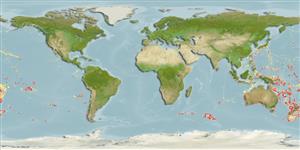Environment: milieu / climate zone / depth range / distribution range
Ecology
Marine; benthopelagic; depth range 580 - 1100 m (Ref. 58302). Deep-water
Western Pacific: in temperate waters; Sagami Bay, Ramapo Bank and Emperor Seamounts (Japan); southeastern Australia, New Zealand north of Clatham Rise and off New Caledonia (Ref. 31777). Central Pacific (Ref. 58302).
Size / Weight / Age
Maturity: Lm ? range ? - ? cm
Max length : 60.5 cm SL male/unsexed; (Ref. 31777)
Found on the continental slope (Ref. 7300, 75154). Benthic or benthopelagic (Ref. 58302, 75154). The species is the largest in the family, an exceed 2 m in length (Ref. 31777).
Life cycle and mating behavior
Maturities | Reproduction | Spawnings | Egg(s) | Fecundities | Larvae
Paxton, J.R., D.F. Hoese, G.R. Allen and J.E. Hanley, 1989. Pisces. Petromyzontidae to Carangidae. Zoological Catalogue of Australia, Vol. 7. Australian Government Publishing Service, Canberra, 665 p. (Ref. 7300)
IUCN Red List Status (Ref. 130435)
Threat to humans
Harmless
Human uses
Tools
Special reports
Download XML
Internet sources
Estimates based on models
Preferred temperature (Ref.
123201): 2.3 - 8.4, mean 6.2 °C (based on 322 cells).
Phylogenetic diversity index (Ref.
82804): PD
50 = 0.5020 [Uniqueness, from 0.5 = low to 2.0 = high].
Bayesian length-weight: a=0.01000 (0.00244 - 0.04107), b=3.04 (2.81 - 3.27), in cm total length, based on all LWR estimates for this body shape (Ref.
93245).
Trophic level (Ref.
69278): 3.5 ±0.5 se; based on size and trophs of closest relatives
Resilience (Ref.
120179): Very Low, minimum population doubling time more than 14 years (Preliminary K or Fecundity.).
Fishing Vulnerability (Ref.
59153): Moderate to high vulnerability (50 of 100).
